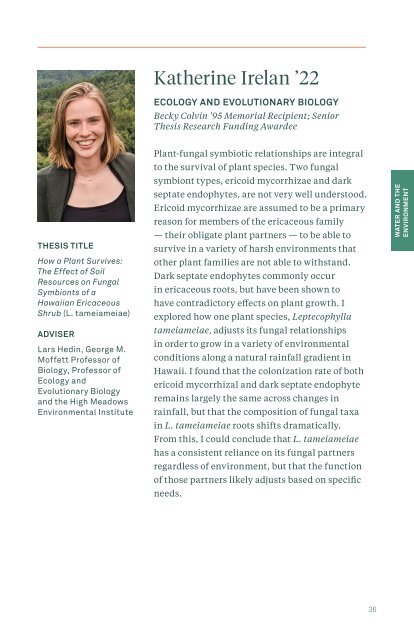Undergraduate Research: An Archive - 2022 Program
Create successful ePaper yourself
Turn your PDF publications into a flip-book with our unique Google optimized e-Paper software.
Katherine Irelan ’22<br />
ECOLOGY AND EVOLUTIONARY BIOLOGY<br />
Becky Colvin '95 Memorial Recipient; Senior<br />
Thesis <strong>Research</strong> Funding Awardee<br />
THESIS TITLE<br />
How a Plant Survives:<br />
The Effect of Soil<br />
Resources on Fungal<br />
Symbionts of a<br />
Hawaiian Ericaceous<br />
Shrub (L. tameiameiae)<br />
ADVISER<br />
Lars Hedin, George M.<br />
Moffett Professor of<br />
Biology, Professor of<br />
Ecology and<br />
Evolutionary Biology<br />
and the High Meadows<br />
Environmental Institute<br />
Plant-fungal symbiotic relationships are integral<br />
to the survival of plant species. Two fungal<br />
symbiont types, ericoid mycorrhizae and dark<br />
septate endophytes, are not very well understood.<br />
Ericoid mycorrhizae are assumed to be a primary<br />
reason for members of the ericaceous family<br />
— their obligate plant partners — to be able to<br />
survive in a variety of harsh environments that<br />
other plant families are not able to withstand.<br />
Dark septate endophytes commonly occur<br />
in ericaceous roots, but have been shown to<br />
have contradictory effects on plant growth. I<br />
explored how one plant species, Leptecophylla<br />
tameiameiae, adjusts its fungal relationships<br />
in order to grow in a variety of environmental<br />
conditions along a natural rainfall gradient in<br />
Hawaii. I found that the colonization rate of both<br />
ericoid mycorrhizal and dark septate endophyte<br />
remains largely the same across changes in<br />
rainfall, but that the composition of fungal taxa<br />
in L. tameiameiae roots shifts dramatically.<br />
From this, I could conclude that L. tameiameiae<br />
has a consistent reliance on its fungal partners<br />
regardless of environment, but that the function<br />
of those partners likely adjusts based on specific<br />
needs.<br />
WATER AND THE<br />
ENVIRONMENT<br />
36
















